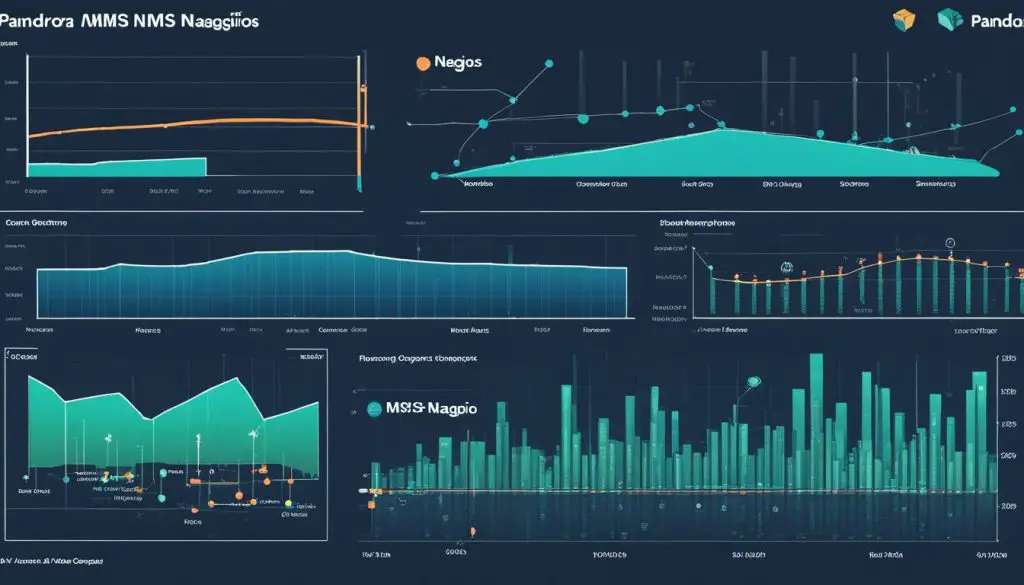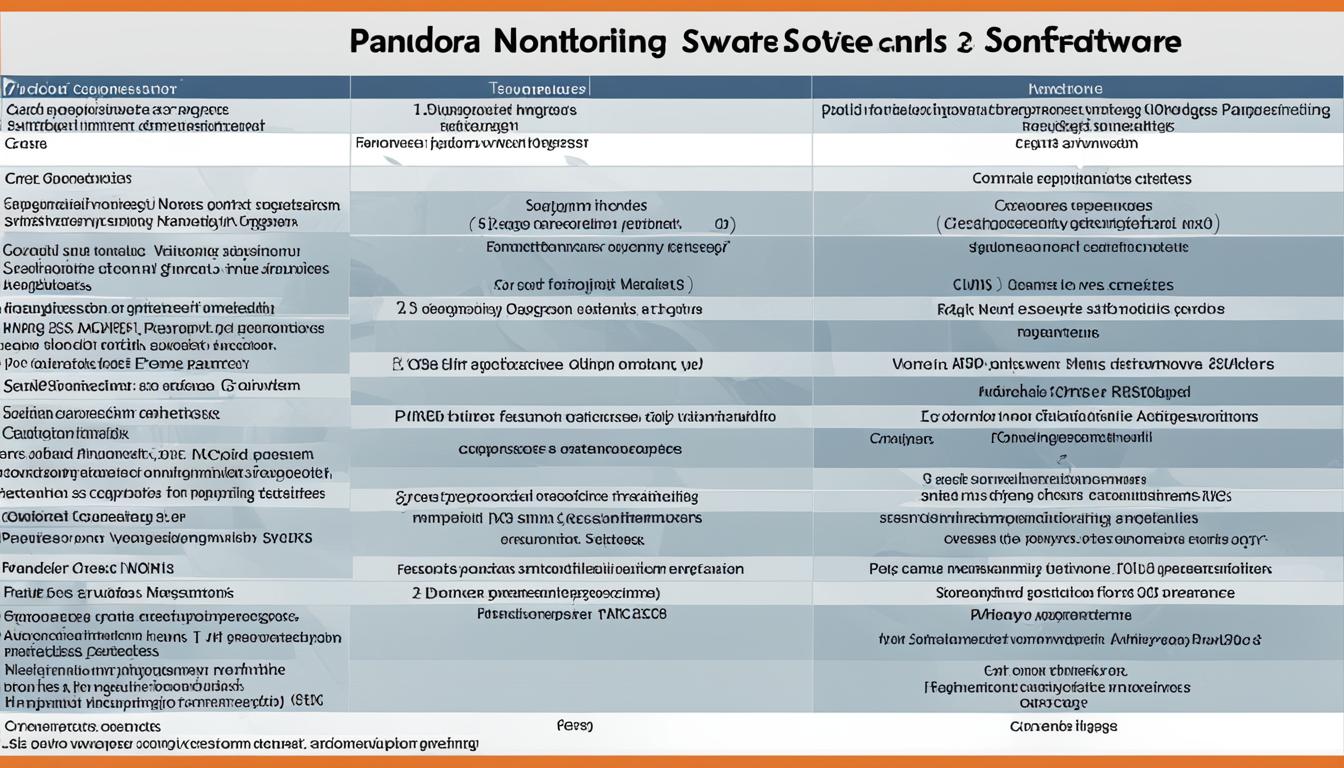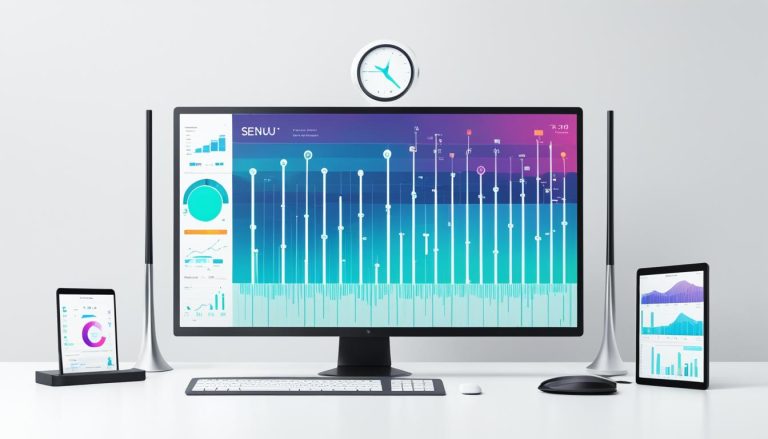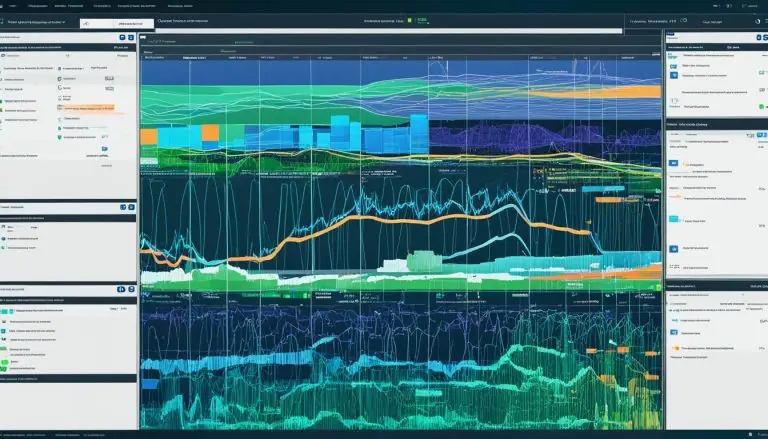Pandora NMS vs. Nagios: Network Monitoring Compared
Are you struggling to choose the best network monitoring software for your organization? With so many options available, it can be challenging to determine which tool will meet your specific needs. That’s why I’ve compared two popular network monitoring solutions: Pandora NMS and Nagios. Get ready to explore their features and capabilities to make an informed decision.
Key Takeaways:
- Pandora NMS and Nagios are both powerful network monitoring tools with their unique strengths and weaknesses.
- Pandora NMS offers flexibility and ease of use, while Nagios has a long-standing reputation and a large user community.
- Consider factors such as user management, plugins, community support, scalability, performance, and cost when evaluating these tools.
- Thoroughly assess your organization’s specific needs and preferences before making a decision.
- Stay tuned to learn more about how Pandora NMS and Nagios compare in various aspects of network monitoring.
Understanding Pandora NMS and Nagios
When it comes to network monitoring systems, Pandora NMS and Nagios are two well-known names in the industry. Let’s take a closer look at each of them.
Pandora NMS is a comprehensive network monitoring system that has been around since 2004. It offers a robust monitoring framework that allows you to monitor various aspects of your network, including infrastructure, performance, and applications. With Pandora NMS, you get a wide range of features and capabilities to ensure the smooth operation of your network.
Nagios, on the other hand, has been a pioneer in open source monitoring since 1999. It has established itself as a “de facto standard” in the industry and has gained a strong foothold over the years. Nagios offers a powerful monitoring solution that has been widely adopted by organizations around the world.
Both Pandora NMS and Nagios have their own unique strengths and capabilities. The choice between the two will depend on your specific requirements and preferences. In the following sections, we will explore various aspects of these network monitoring systems to help you make an informed decision.
User Management and Configuration
When comparing Pandora NMS, Nagios, and Zabbix, an important aspect to consider is user management and configuration. This plays a significant role in the usability and efficiency of the monitoring tools. Let’s explore how each solution handles user management and configuration.
Pandora NMS: User-Friendly Interface and Additional Features
Pandora NMS offers a web-based management interface that simplifies user management and configuration tasks. The intuitive interface allows users to easily add, modify, and delete user accounts within the system. User permissions can be customized, ensuring the right level of access for different roles and responsibilities. Additionally, Pandora NMS provides integration with Lightweight Directory Access Protocol (LDAP), enabling seamless user authentication and centralized management.
Nagios: Complex Management System
On the other hand, Nagios utilizes a more complex user management system that involves multiple text files and manual processes. Setting up and managing user accounts in Nagios may require a deeper understanding of the underlying configuration files. The process can be challenging and time-consuming, especially for users with limited technical expertise.
Zabbix: Web-Based Management Interface
Similar to Pandora NMS, Zabbix offers a web-based management interface that simplifies user management and configuration tasks. This user-friendly interface allows administrators to easily create and manage user accounts, assign roles and permissions, and configure access controls. The intuitive interface streamlines the process, reducing the learning curve for new users.
“Pandora NMS and Zabbix provide web-based management interfaces that simplify user management and configuration tasks.”
Overall, Pandora NMS and Zabbix excel in providing user-friendly interfaces for user management and configuration. Their web-based management interfaces streamline the process, making it easier for administrators to set up and manage user accounts. Nagios, on the other hand, requires a deeper understanding of its complex configuration files and may pose challenges for users with limited technical expertise.
Plugins and Out-of-the-Box Monitoring
When it comes to choosing a network monitoring tool, the availability of plugins and out-of-the-box monitoring capabilities is a crucial factor to consider. Both Nagios and Zabbix require the installation of various plugins to provide a complete set of features for monitoring. However, it’s important to note that Nagios lacks an official plugin library, relying instead on a poorly maintained open-source library.
Pandora FMS, on the other hand, offers a smaller plugin library but excels in its collection of ready-to-use plugins that are suitable for everyday monitoring needs. These plugins ensure a smooth and seamless monitoring experience right out of the box, saving valuable time and effort. With a range of pre-built plugins, Pandora FMS provides users with the essential monitoring capabilities they need without the hassle of searching for and configuring additional plugins.
By offering out-of-the-box monitoring capabilities, Pandora FMS stands out as a user-friendly and convenient solution. The ability to start monitoring immediately without the need for extensive plugin installations allows users to focus on network performance and stability.
Furthermore, Pandora FMS provides a platform that is continuously updated and improved, ensuring that users have access to the latest monitoring functionalities without the need for manual plugin updates. This commitment to staying up-to-date and providing a seamless experience further enhances the effectiveness and efficiency of monitoring operations.
Ultimately, the availability of plugins and out-of-the-box monitoring capabilities is an important aspect to consider when evaluating network monitoring tools. While Nagios and Zabbix may require additional plugins for a complete set of features, Pandora FMS offers a compelling solution with a range of ready-to-use plugins that simplify and streamline the monitoring process.
Community Support and User Community
The success of a monitoring tool is often influenced by the size and support of its user community. In the case of Nagios, its extensive history in the industry has resulted in the largest and oldest community. This strong community presence has contributed to the wealth of resources, plugins, and support available for Nagios users.
Zabbix and Pandora FMS also have growing communities that continue to expand. Zabbix, in particular, offers certified training for users, further enhancing its community support. The Zabbix community is actively engaged in sharing knowledge and providing assistance to fellow users.
While the Pandora NMS community may not be as large as Nagios or Zabbix, it has a strong presence, especially in Spanish-speaking countries. The community actively contributes to the development and improvement of Pandora NMS, providing valuable feedback and support.
Being part of a thriving user community can be a significant advantage when using a monitoring tool. Access to a network of experienced users, forums, and resources can facilitate troubleshooting, knowledge sharing, and the discovery of new use cases. Therefore, when considering a monitoring solution, it is essential to evaluate the size and support of the user community.
If you’re interested in seeing what the user community can offer, check out the image below to get a glimpse of the Pandora FMS user forums:
Note: The image above showcases the vibrancy and collaboration within the Pandora FMS user community.
Report and Visual Dashboard Generation
Generating reports and visual dashboards is an essential aspect of effective monitoring for any network monitoring tool. In this section, we will explore how Pandora FMS, Nagios, and Zabbix handle the generation of reports and visual dashboards to provide valuable insights into your network’s performance and health.
Pandora FMS
Pandora FMS offers a comprehensive solution for report generation and visual dashboard creation. With its user-friendly interface, users can easily customize and generate detailed reports that provide in-depth information about network performance, availability, and trends. The visual dashboard feature in Pandora FMS allows users to monitor real-time data through visually appealing and interactive dashboards, empowering them to identify issues and take necessary actions promptly.
Nagios
While Nagios is a powerful network monitoring tool, it requires additional plugins to enable graphical representation and visual dashboards. Users must rely on third-party plugins to create visual representations of network data. This additional setup and configuration can be cumbersome and time-consuming, making it less user-friendly compared to Pandora FMS and Zabbix.
Zabbix
Zabbix, on the other hand, simplifies the process of creating visual dashboards by including it as a standard feature. Users can easily customize dashboards, integrating various graphs, charts, and widgets to showcase real-time network data. This streamlined approach allows for quick and intuitive data interpretation, making it an effective tool for monitoring large-scale networks.
In the words of a satisfied Zabbix user: “Zabbix’s visual dashboard feature has transformed the way we monitor our network. The customizable interface and real-time data visualization provide valuable insights into our infrastructure’s performance, allowing us to proactively address issues and improve our overall network efficiency.”
Overall, when it comes to report generation and visual dashboard creation, Pandora FMS and Zabbix offer more user-friendly and convenient solutions compared to Nagios. Pandora FMS takes the lead with its flexibility in report generation and intuitive visual dashboard features, allowing users to efficiently monitor and analyze their network’s performance.
Agent-Based Monitoring
Agent-based monitoring plays a vital role in gaining deeper insights into network performance. It allows for comprehensive data collection, enabling organizations to have a more in-depth understanding of their network infrastructure. When comparing monitoring tools like Pandora FMS, Nagios, and Zabbix, it is important to consider their support for agent-based monitoring.
Nagios and Zabbix are two solutions that offer agent-based monitoring options. These options provide a more comprehensive approach to data collection, allowing monitoring agents to gather detailed information from various network devices. This enables organizations to monitor not only the overall health of the network but also the performance of individual devices and applications.
However, it is worth noting that Nagios requires manual configuration and maintenance of custom scripts for implementing agent-based monitoring. This can be a time-consuming task and may require technical expertise to set up and manage effectively.
On the other hand, Pandora FMS also supports agent-based monitoring but with a focus on simplicity and ease of use. The tool provides a user-friendly interface that allows users to easily configure and deploy monitoring agents across their network. This streamlined approach simplifies the process of implementing agent-based monitoring, making it accessible to organizations of all sizes.
“Agent-based monitoring is crucial for organizations who want real-time visibility into the performance of their network infrastructure. While tools like Nagios and Zabbix offer this capability, Pandora FMS stands out for its user-friendly approach, making agent-based monitoring accessible to both technical and non-technical users alike.”
By leveraging agent-based monitoring capabilities, organizations can gain deeper insights and take proactive actions to optimize their network performance. Whether you choose Nagios, Zabbix, or Pandora FMS, it is important to consider your specific requirements, technical expertise, and ease of use when selecting a solution that best fits your organization’s needs.
Related: How Agent-Based Monitoring Works
Agent-based monitoring involves deploying monitoring agents or software agents on individual devices or servers to collect performance data. These agents gather information such as CPU usage, memory usage, network traffic, and application-specific metrics. The collected data is then sent to a central monitoring system, where it is processed and presented in a meaningful way to network administrators and operators.
The use of agent-based monitoring enables organizations to have a more granular and detailed view of their network’s performance. It allows for real-time monitoring, proactive issue detection, and efficient troubleshooting. By leveraging agent-based monitoring, organizations can ensure optimal performance, minimize downtime, and provide a seamless user experience.
Scalability and Network Environments
The scalability and adaptability of a monitoring tool are crucial for growing network environments. To meet the needs of large-scale environments, Pandora FMS claims to support up to a million nodes. Its distributed architecture ensures efficient monitoring across complex networks, making it an ideal choice for organizations experiencing rapid growth and expansion.
Nagios and Zabbix also offer options for distributed monitoring in network environments. While they may require additional configuration and setup compared to Pandora FMS, they provide the scalability necessary to monitor expansive networks effectively. These tools enable businesses to stay on top of their network performance and ensure seamless operations as their network environments evolve.
“The scalability and adaptability of a monitoring tool are crucial for growing network environments.”
Performance and Reviews
When evaluating network monitoring tools, assessing their performance and reading user reviews are crucial steps. Let’s take a closer look at how Pandora FMS, Nagios, and Zabbix fare in terms of performance and what users have to say about them.
The Stability and Reliability of Nagios
In the realm of network monitoring, Nagios has stood the test of time. It has been widely used for many years and has proven its stability and reliability in diverse environments. The tried and tested nature of Nagios makes it a popular choice for those seeking a dependable monitoring solution.
Zabbix’s Holistic Approach to Monitoring
Zabbix, on the other hand, has been gaining popularity for its more holistic monitoring approach. With a comprehensive set of features, Zabbix offers a robust solution that covers various aspects of network monitoring. Its performance and capabilities make it an attractive option for those looking for a comprehensive monitoring solution.
Pandora FMS: Flexibility and Ease of Use
Pandora FMS has garnered a strong reputation, especially in Spanish-speaking countries. One of its notable strengths is its flexibility, allowing users to tailor the monitoring system to their specific needs. With an intuitive interface and user-friendly features, Pandora FMS provides ease of use that caters to both beginners and experienced users.
“Pandora FMS’s flexibility allows us to adapt it to our unique monitoring requirements. We’ve been able to streamline our monitoring processes and achieve better overall performance.”
Overall, the performance of these network monitoring tools varies, and it’s important to consider individual requirements and preferences before making a decision. The opinions and experiences of users can provide valuable insights into the strengths and weaknesses of each tool, helping you make an informed choice.
Cost and ROI
When it comes to selecting a network monitoring solution, cost is a crucial consideration. In this section, I will provide insights into the cost and return on investment (ROI) of three popular tools: Pandora FMS, Nagios, and Zabbix.
Nagios: Free, but Requires Time and Resources
Nagios is an open-source tool that offers a free solution for network monitoring. While it may be tempting due to its cost-effectiveness, it’s important to note that Nagios requires significant time and resources for setup and configuration. This can impact the overall ROI, as you will need to allocate resources to ensure its proper implementation.
Zabbix: Options for Open-Source and Enterprise Editions
Zabbix provides flexibility in terms of pricing options. It offers both open-source and enterprise editions, allowing you to choose the one that best suits your needs. However, it’s important to consider the associated costs for support and implementation services, which should be factored into your decision-making process.
Pandora FMS: Free Open-Source Version with Enterprise Features
Pandora FMS offers a free open-source version that is suitable for most monitoring needs. This can significantly reduce upfront costs compared to other solutions. Additionally, Pandora FMS provides a range of enterprise features that can be tailored to larger environments, offering scalability and long-term value. It’s essential to consider the ROI and the long-term benefits of these additional features when evaluating the cost of Pandora FMS.
Ultimately, the cost and ROI of each network monitoring tool will depend on your specific requirements and budget. Consider the initial setup costs, ongoing maintenance expenses, and the long-term value that each tool can provide. By evaluating the costs and benefits, you can make an informed decision that aligns with your organization’s goals and objectives.

Conclusion
In conclusion, both Pandora NMS and Nagios are powerful network monitoring tools with their own strengths and weaknesses. Nagios has a long-standing reputation and a large user community, making it a popular choice for many organizations. Its extensive plugin library and robust monitoring capabilities are well-regarded in the industry. However, Nagios does require manual configuration and maintenance, which can be time-consuming and complex.
Pandora NMS, on the other hand, offers a more user-friendly experience with its web-based management interface and out-of-the-box plugins. Its flexibility and ease of use make it an attractive option, particularly for organizations looking for a monitoring solution that is easy to deploy and maintain.
Ultimately, the choice between Pandora NMS and Nagios will depend on your organization’s specific needs and preferences. Consider factors such as scalability, user support, and cost when making your decision. It is recommended to thoroughly evaluate the features and capabilities of each tool to ensure it aligns with your monitoring requirements and provides a satisfactory return on investment.
FAQ
What is Pandora NMS?
What is Nagios?
How do Pandora NMS, Nagios, and Zabbix compare in terms of user management and configuration?
Do Pandora NMS, Nagios, and Zabbix differ in terms of available plugins and out-of-the-box monitoring capabilities?
How do the user communities for Pandora NMS, Nagios, and Zabbix compare?
Are there differences in report and visual dashboard generation among Pandora NMS, Nagios, and Zabbix?
Do Pandora NMS, Nagios, and Zabbix support agent-based monitoring?
How do Pandora NMS, Nagios, and Zabbix compare in terms of scalability and adaptability?
What can you tell me about the performance and user reviews of Pandora NMS, Nagios, and Zabbix?
How do the costs of Pandora NMS, Nagios, and Zabbix compare?
Which network monitoring tool should I choose between Pandora NMS and Nagios?
Source Links
- https://pandorafms.com/blog/zabbix-vs-nagios-vs-pandorafms-an-in-depth-comparison/
- http://www.edugeek.net/blogs/victormadrid/2275-nagios-zabbix-pandora-fms-comparison.html
- https://www.trustradius.com/compare-products/nagios-core-vs-pandora-fms
- About the Author
- Latest Posts
Janina is a technical editor at Text-Center.com and loves to write about computer technology and latest trends in information technology. She also works for Biteno.com.






